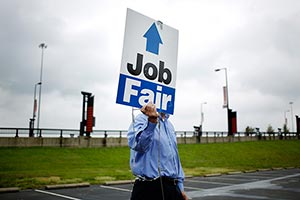Labor Market in US Is Getting Better by Almost Any Measure

America’s labor market might not be as great yet as President Trump wants, but by almost any measure, it’s getting better.
Employers added an above-forecast 235,000 positions in February, while measures of joblessness and underemployment improved, the Labor Department’s monthly report showed on March 10. Wage growth picked up and the share of prime-age Americans in the labor force rose to the highest since 2011, suggesting the economy’s strength is drawing people off the sidelines.
While some of the labor-market gains in February can be chalked up to unseasonably warm weather, particularly in construction, the figures are still solid and effectively seal a Federal Reserve interest-rate increase next week. Analysts expect wage gains to accelerate further gradually, which will underpin consumer spending, the principal driver of economic growth, amid a first quarter that’s looking tepid.
RELATED: Trucking industry boosts payrolls by 10,600 in February
“If you dig a bit deeper, there are three strong reasons for optimism: in the weather-adjusted data, in the wage growth and in the unemployment and participation rate,” said Gregory Daco, head of U.S. macroeconomics at Oxford Economics in New York.
Daco estimated that “weather-sensitive sectors” added about 75,000 jobs in February. Construction jobs rose by 58,000, the strongest gain in almost a decade, and followed a 40,000 increase in January.
The report reinforces prospects for two more Fed rate increases this year after an anticipated move in the week of March 13, while giving Trump a political boost with numbers that represent his first full month in office. “GREAT AGAIN: +235,000,” Trump posted on his Twitter account in a retweet of a Drudge Report headline and link to a Bloomberg News article on the employment data.
RELATED: Jobless claims rebounded last week from four-decade low
Goods-producing industries, which include mining, construction and manufacturing, added 95,000 jobs in February, the most since 2000. The latest figures are “consistent with the cyclical upturn in industrial activity around year-end” in the United States and other developed economies, said Michael Gapen, chief U.S. economist at Barclays in New York.
Consumer and business optimism for the economy have surged since Trump’s election, and that could result in a “modest boost in hiring,” but it will take actual policy changes to drive investment by companies, Gapen said. Such spending has been relatively lackluster over the past year.
“Yes, the sentiment has improved and equity valuations have risen, financial conditions have eased,” said Gapen, who previously worked at the Fed. “The longer that stays around, yes, you’d expect it to matriculate into some hard data, including labor market data. But at some point, you have to have the policies — otherwise that sentiment will reverse.”
Trump, who called the main unemployment rate “phony” during the campaign, can take comfort from improvement in several other gauges of the labor market.
RELATED: Companies in US hired the most in almost three years, ADP says
The prime-age participation rate, which covers people ages 25 to 54, is a measure that Trump previously had highlighted as deteriorating under President Obama. That level rose to 81.7% in February, up from 80.6% in September 2015, which matched the lowest since 1984.
Another measure of labor market slack, the U-5 rate, fell to 5.7% from 5.8%, matching the lowest level since 2007. Cited as an alternative indicator by Treasury Secretary Steven Mnuchin, the rate includes discouraged workers as well other so-called marginally attached workers, who aren’t working or actively looking for work but want a job.
The U-6, or underemployment rate, fell to 9.2%, which matched the lowest figure since 2008. That rate also includes part-time employees who want full-time work.
While not all the February data were strong — retail jobs fell 26,000, reversing part of a gain of almost 40,000 in January — economists saw many encouraging signs in the data, from hiring to the pickup in wages and rising participation.
“We read the report as strong in all categories and expect it will give the Fed more confidence in pursuing three rate hikes this year,” Citigroup Inc.’s Andrew Hollenhorst and Andrew Labelle said in a note.
With assistance from Michelle Jamrisko and Shobhana Chandra.

